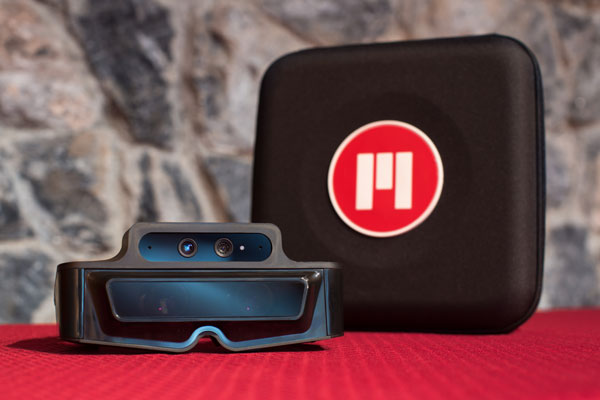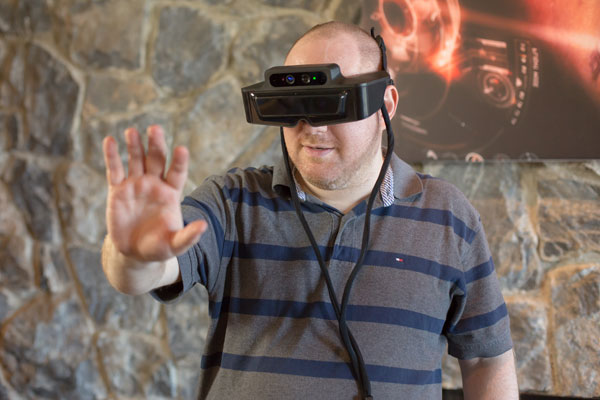I Am Iron Man: My Time with the Meta 1 AR Glasses
The Meta 1 augmented reality glasses could change shopping, entertainment and even medicine. We go hands-on.
Google Glass may be the world's most famous heads-up display, but it's hardly the most useful or technologically advanced, offering little more than a low-res camera and a set of notifications on your face. With a lot less fanfare, Silicon Valley startup Meta is building a wearable platform that uses complex gesture recognition and immersive dual-eye glasses to create an augmented-reality environment worthy of Tony Stark.
I recently had a chance to visit the company's headquarters and get a look at how its glasses could change the ways we work, shop and learn.
Nestled at the end of a private road on the side of a mountain in Portola Valley, California, Meta's campus is the former mansion of eccentric millionaire Jacques Littlefield, who was known for having one of the world's largest collections of vintage tanks. Some of the tanks remain on the property, along with a tennis court, an orange grove and an in-ground swimming pool. A mountainside mansion seems like an odd office for a technology startup, but marketing director Matt Kitchales assured us that the atypical environment helps inspire Meta's 65 employees, most of whom live on the grounds.
MORE: Augmented Reality Makes Us More Human
The main house looks more like a family home, with major demos occurring in front of a stone fireplace, which is adorned by a poster of Robert Downey Jr. as Iron Man. The company has hired Hollywood designer Jayse Hansen, who created the 3D UIs for the Iron Man 1 and 3 movies, as its UI director and makes no secret of its desire to emulate the experience moviegoers see in sci-fi films like Minority Report.

This month, the company begins shipping its Meta 1 development kit to supporters who backed the project on Kickstarter. The kit consists of glasses that cover both eyes, providing a 960 x 540-pixel projection on top of what the user sees through the transparent lenses. The device comes with two different hoods that go on top of the lenses: the default hood, which provides a 23-degree field of view, and the FOV expander, which offers a 32-degree field of view that is more immersive but makes it harder to see the world around you.

The Meta 1 glasses have both a 320 x 240 depth-perception camera for accurate gesture detection and a 720p regular camera for capturing stills and video. The device also has dual microphones, speakers and an IMU (inertial measurement unit) that detects your head movements. Because it's a developer kit, not a consumer-grade wearable, the Meta 1 gets all of its processing power from your PC and must remain tethered via USB at all times.
Get instant access to breaking news, the hottest reviews, great deals and helpful tips.

While it's tempting to compare Meta's platform with the well-known Oculus Rift gaming headset or with Google Glass, neither of those devices provides an augmented reality environment, which combines the user's real-world perspective with virtual objects and controls. Designed for gaming, the Oculus Rift completely covers users' eyes and places them in a virtual reality world. Glass could be used for AR, but it only appears in a tiny space above one eye and has few apps that put virtual information on top of the real world. Epson's Moverio BT-200 also provides a dual-eye, AR experience, but primarily works with regular Android apps.
Web Surfing

The Meta 1 felt very comfortable on my head, fitting over my thick glasses without smushing them against my face. During a brief hands-on, I was able to surf the Web with Meta's custom browser, which put translucent windows in front of my face.
Moving a hand in close to each window, I was able to make a fist and grab it, then drag it to another part of the room, even leaving a virtual browser window on the real-world table in front of me as two others floated to my left and right. I also used a single finger to tap links within the browser. Meta's CEO Meron Gribetz said that, on his Windows computer, he uses the glasses to show additional desktops in the air, right next to his real monitor, but that's not a standard feature of the development kit.
MORE: 12 Best Augmented Reality Apps
Shopping and Repairs
Despite the browser window demo, the Meta 1's purpose is not to replicate desktop computing in the virtual space, but to provide a whole new range of applications. During my visit, a company developer put on the glasses and demonstrated how they might be used for online shopping, as he explored a virtual 3D Tesla car, rotating it, opening its doors and zooming into the interior. He also explored a virtual bicycle, showing how the glasses can help engineers design new products or serve as a 3D instruction manual for repair people.
Medical Training
If you can learn by exploring a car or an engine, why not a virtual human? SimX, a local startup, has created a detailed patient simulator that uses the Meta 1 to train doctors in emergency medicine. Company CEO Ryan Ribeira explained that most hospitals and medical schools today use expensive $250,000 test dummies for trauma training. With the glasses and software, these institutions can get even more detailed training programs for a fraction of the cost. As a member of Meta's Pioneer Program, SimX is among a handful of companies that have had early access to the device and the Meta developers behind the platform.
As I watched, SimX CMO Dr. Srihari Namperumal used the Meta 1 to examine a virtual patient who was lying down on top of a very real gurney. In this particular simulation, the subject was a young girl who complained of headaches after hitting her head on the playground. Namperumal used his real stethoscope to take the virtual girl's pulse, then used a sonogram sensor to have a look inside her chest cavity. During the exam, the girl began having a seizure and Ribeira injected her with medicine, using a real syringe.

MORE: Best Smartwatches 2014
Holographic Movies, Assistants and Chats
Another Meta Pioneer Program, the Holograam company, recently posted a video showing how it used the Meta 1 glasses to recreate the famous Princess Leia projection from Star Wars. In the clip, developers use the Meta 1 to see a 3D model of Carrie Fisher on top of a real cardboard box, moving and saying, "Help me, Obi Wan Kenobi. You're my only hope."
Holograam CEO Francisco Carzoglio explains that his company is working on what it calls the Leia Project, a platform he describes as "like a holographic YouTube where users will be able to upload, share and sell their own 3D content." He also says that his company is working to create real-time chat with holographic avatars and virtual assistant avatars to help you through your day.
Outlook
Now that the Meta 1 is shipping to the programmers who pre-ordered it, we should see a whole new ecosystem of apps. According to early partners such as Ubimax CEO Hendrik Witt, the Meta SDK is easy to use. "In less than 48 hours, we could build running applications where we would have needed much more time with other technologies," he said in a video clip about his company's AR software for factories. The Meta SDK runs on Windows and is powered by the popular Unity 3D engine.

Developers who haven't already pre-ordered the Meta 1 kit will be able to purchase it from the company's website (getameta.com) for $667, starting today (Sept. 18).
While developers will get a kick out of the Meta 1, end users will want to wait for the Meta Pro, which should ship sometime next year, and comes with a battery pack and portable Core i5 computer so you can walk around with it on. I got a look at a very early version of the Meta Pro at CES 2014 and found the $3,650 device very intriguing.
Most consumers probably don't have $3,650 or even $667 to spend on a new and unproven technology, but every great gadget revolution begins with deep-pocketed early adopters. When they put on their glasses, Meta users could be staring into the future.
-
surphninja This could make for some really interesting board games. Real boards but with moving game pieces.Reply
It would also be cool to see interactive storybooks, like the Wonderbook, that wouldn't require you to watch the tv to see the action.
